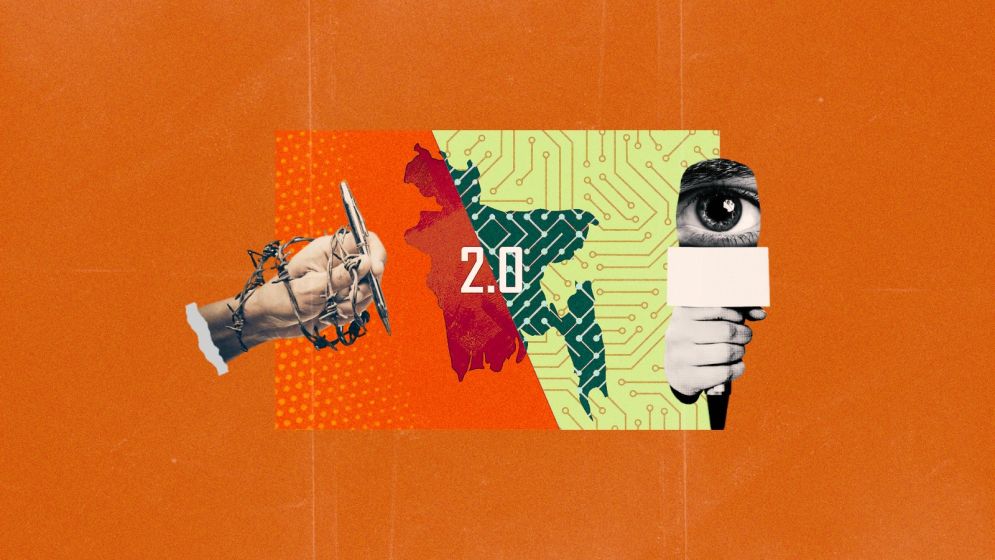Post-Hasina Bangladesh still failing the free press test

On the morning of Tuesday, 29 April, the July Revolutionary Alliance (JRA) published a series of Facebook posts criticising three journalists from ATN Bangla, Deepto TV, and Channel i.
The posts accused the journalists of speaking “in favour” of the former “fascist” Hasina government during a press conference held the previous day by Culture Advisor Mostofa Sarwar Farooki.
At the press conference, journalists challenged Farouqi on his claim that 1,400 people were killed during the July–August 2024 protests, pressing him on the credibility of the figure.
They also questioned how he could assert that Sheikh Hasina was responsible for ordering the killings when she had not yet been convicted.
One journalist further asked how the interim government could speak of “inclusivity” when the newly renamed Anondo Shobhajatra featured an effigy of Hasina depicted in a witch-like manner.
Later that day, the JVA, a student group based in Uttara that documents the protest-related killings, posted: “If action is not taken against these three journalists within 24 hours, march to Deepto TV, Channel i, and ATN Bangla.”
By evening, all three broadcasters had dismissed the journalists in question, and Deepto TV announced the temporary suspension of its news operation.
Whilst the questions posed at the press conference are undoubtedly sensitive, and uncomfortable for the government, they are well within the scope of responsible journalism.
Farouqi and other government officials have cited the estimate of 1,400 deaths given in the final report of the UN Office of the High Commissioner for Human Rights’s (OHCHR) Fact-Finding mission rather than the government’s own Ministry of Health’s verified count of 834. This discrepancy merits scrutiny.
On page 10 of its report, OHCHR states that it arrived at the higher number by adding to the government figure details of a further 314 deaths given to it by the National Security Intelligence (NSI) which were apparently not recorded by the Ministry of Health, and by consolidating data from civil society organizations after removing duplicates.
As the report concludes, “Based on this data, OHCHR assesses that there could have been as many as 1,400 protest-related deaths.”
Given that the government’s own count on the number of deaths is based on sounder documentation including death certificates, it is entirely appropriate for journalists to question why the administration prefers a higher, less transparent figure backed by unpublished NSI data and civil society lists.
Moreover, in using the 1400 figure, the government ignores an important fact that the number includes deaths of law enforcement personnel and Awami League activists at the hands of protestors or others in support of the protests, which the UN report claims were about one fifth of all the total deaths.
As to the reporter’s question about referring to Sheikh Hasina as a “killer” before any legal judgment has been given, it is surely valid for a reporter to question the language used by government advisers if it could risk undermining her right to a fair trial.
While it may not be possible to stop citizens from expressing such views, (and arguably there are certainly grounds for using that language), government representatives should arguably be held to a higher standard of impartiality.
And as to the third question, surely reporters should be able to question the use of a witch-like effigy of Hasina at the Anondo Shobhajatra, even if many liked it being there. Holding government officials accountable for their language and decision making is an important function of a free press.

Editorial oversight and caving in to public
demand
That said, given Bangladesh’s volatile political climate, and in particular the anger relating to Awami League’s responsibility for the July and August killings, these were clearly touchy questions.
It would therefore have been prudent for the journalists to consult with their news editors before raising them in a press conference, particularly one which was meant to be focused on the selection of the short film “Ali” for the 78th Cannes Film Festival, and not on wider political issues.
If the reporters did not seek prior approval—something that seems not to have happened—then their respective TV stations may reasonably feel aggrieved at having been drawn into controversy through their reporters’ questioning zeal.
Still, this does not justify the severity or speed of the response. The journalists should not have been fired, especially in reaction to threats on social media. Disciplinary measures would have been a far more appropriate sanction.
What is most concerning is the rise of censorship driven by online intimidation. Student groups and affiliated organizations are increasingly using threats of “mob” action—both online and offline—to silence journalists and sway editorial choices.
This emerging tactic is having a chilling effect on press freedom, leading many media outlets to steer clear of sensitive yet critical issues.
The swift compliance of the three broadcasters with the JVA’s demands risks encouraging other groups to adopt similar coercive tactics. To safeguard journalistic integrity, Bangladeshi media must show greater resistance to such pressure.
If this pattern continues, the already limited space for independent journalism will shrink further.
Although Farouqi himelf did not seem too perturbed by the questions and the interim government did not directly order the journalists’ dismissal or the suspension of Deepto TV’s news division, it does bear responsibility for safeguarding media freedom.
It is therefore troubling that Mahfuj Alam, the new Information Ministry Advisor, characterized the journalists’ questions as “seemingly supporting genocide.”
This is an a problematic misrepresentation. The reporters asked crucial questions that any serious journalist should feel entitled—and indeed obligated—to ask, as long as it is done in a professional manner.
Bangladesh’s media landscape is at a crossroads. The firing of these journalists sends a stark warning. Unless there is a concerted pushback against both state and non-state pressures, the future of press freedom in the country will be in jeopardy.
—-
David Bergman is a journalist based in the UK and Bangladesh. He has long been covering Bangladesh affairs. He can be followed on X @TheDavidBergman

